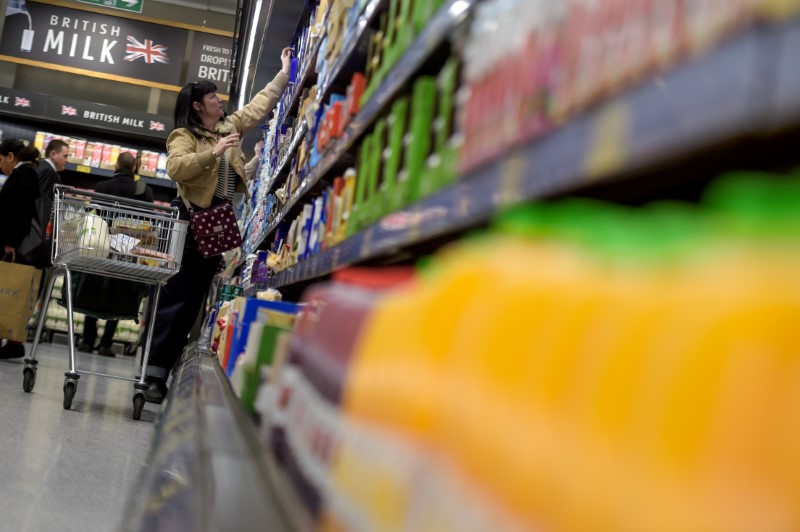 © Reuters. FILE PHOTO: A shopper reaches to a high shelf in an Aldi store in London
© Reuters. FILE PHOTO: A shopper reaches to a high shelf in an Aldi store in LondonBy Andy Bruce and William Schomberg
LONDON (Reuters) – British inflation fell unexpectedly in April, according to data that prompted fresh questions about when the Bank of England would next raise interest rates and pushed sterling to its lowest level against the dollar this year.
Consumer prices rose by an annual 2.4 percent, the Office for National Statistics said on Wednesday, marking a 13-month low as the timing of the Easter holidays meant air fares pushed down on inflation last month.
Although the BoE had expected inflation to ease in April, most economists in a Reuters poll thought it would hold steady at 2.5 percent and some had forecast a rise. It was the second surprise fall in a row after a drop in March’s figures.
“With consumers remaining cautious and borrowing appearing to have fallen substantially, a rate hike over the next few months is certainly not a done deal,” ING economist James Smith said.
Investors priced in a one-in-three chance of the BoE raising borrowing costs in August — the next time it updates its economic forecasts — down from 50/50 earlier this week.
Two weeks ago the BoE refrained from a hike that had at one point been widely expected as it waited to see if the economy’s weak start to the year simply reflected heavy snowfall.
A Reuters poll of economists, conducted before Wednesday’s data, showed most still expected an August hike. [BOE/INT]
High inflation, caused by the pound’s drop after the 2016 Brexit vote, squeezed British consumers last year. Although it has receded from its November peak of 3.1 percent, it is running above the BoE’s target of 2.0 percent.
On Tuesday, Bank of England Governor Mark Carney cited a new sugar tax on soft drinks, as well as higher utility bills and petrol prices, as reasons why inflation in Britain “probably tips up a bit” in the coming months before resuming a decline.
The ONS said soft drink prices rose sharply over the last couple of months but the overall impact on inflation was small.
Data last week showed inflation in the euro zone also slowed in April.
Wednesday’s figures pointed to some signs of inflation pressure still in the pipeline in Britain.
Prices of goods leaving factories increased at a faster rate than expected last month and the cost of raw materials — many of them imported such as oil — was 5.3 percent higher than in April 2017, up sharply from an increase of 4.4 percent in March and suggesting a long run of weakening price growth has ended.
Fusion Media or anyone involved with Fusion Media will not accept any liability for loss or damage as a result of reliance on the information including data, quotes, charts and buy/sell signals contained within this website. Please be fully informed regarding the risks and costs associated with trading the financial markets, it is one of the riskiest investment forms possible.
Source: Investing.com




























